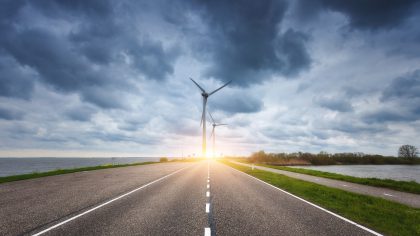Pre-Combustion CO₂ Capture Add-on for Power Plants – solid fuels
In this factsheet a generic solution to capture CO2 before combustion of solid fuels such as coal, solid biomass or municipal solid waste (MSW) in power plants is considered. Reference technology is integrated gasification combined cycle (IGCC) plant, where syngas (a mix between CO, CO2 and H2) is produced from which CO2 can be captured before the syngas is combusted in a combined cycle plant.
Downloads
Download hier de datasheet (PDF)Depending on the fuel used, there are different requirements for syngas cleaning in preparation for CO2 capture (dust filters, NOx removal, sulphur scrubbers, etc.), which will impact performance and costs. The performance and cost ranges are considered to be sufficiently close for the variety of solid fuels to group them together in a single factsheet.
The focus of this factsheet is solely on CCS for IGCC plants. The reference is IGCC plants without CCS and all reported data is relative to the reference plant (e.g. investment costs are additional costs for CCS and exclude investment costs for the IGCC plant, such as the gasification unit).
There are a variety of techniques that can be used to separate CO2 from the syngas, including using sorbents/solvents, membranes and distillation machinery (IEA, 2013). After gasification the CO2 concentration in the syngas is 8-20 %, which is potentially higher than the concentration after combustion (12-14%) (IPCC, 2005). Physical solvents, such as Selexol, are the most commonplace technique for pre-combustion capture for IGCC power plants (Rubin et al., 2015a), therefore they are considered the default for this factsheet. Similar to chemical solvents, CO2 is attached to the physical solvents in an absorber after which the solvents are separated and regenerated using steam to release the CO2 and enable reuse of the solvent (IEAGHG, 2014a).
Compression and dehydration are part of the CO2 capture process. Reports on CO2 pressure after capture vary from 8 MPa to 20 MPa in the studies cited here. At these pressure levels it is possible to transport the CO2 through low-pressure pipelines (maximum pressure of 4.8 MPa) or high-pressure pipelines (minimum of 9.6 MPa) (IPCC 2005) with minimal additional (de)compression required. It is therefore assumed that no additional compression step is required after capture to prepare the CO2 for pipeline transport. If CO2 is transported in liquid state, then additional compression will be required.
All information in the datasheets is also available in ESDL (Energy System Discription Language). You can find them in the Energy Data Repository (EDR).Gerelateerde publicaties

De weg naar duurzame mobiliteit over land, water en door de lucht
Klimaatneutrale mobiliteit in 2050

Potentieel van e-fuels voor zwaar wegtransport
Wat is het techno-economische potentieel van e-fuels voor gebruik in vrachtwagens in Nederland?

Techno-economisch potentieel nul-emissie vrachtwagens in Europa
Batterij-elektrische trucks tegen 2030 inzetbaar in merendeel van de toepassingen